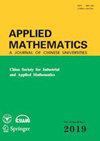时滞Volterra积分方程的收敛性分析
IF 1
4区 数学
Applied Mathematics-A Journal of Chinese Universities Series B
Pub Date : 2022-06-16
DOI:10.1007/s11766-022-3563-1
引用次数: 0
摘要
本文用切比雪夫谱配置法处理具有两类时滞项的Volterra积分方程。我们使用线性变换将区间变为固定区间[-1,1]。然后我们使用高斯求积公式来近似解。借助于引理,我们得到了数值误差在无穷远范数和Chebyshev加权Hilbert空间范数中呈指数衰减的结果。数值实验证实了我们的理论预测。本文章由计算机程序翻译,如有差异,请以英文原文为准。
Convergence analysis for delay Volterra integral equation
In this article we use Chebyshev spectral collocation method to deal with the Volterra integral equation which has two kinds of delay items. We use linear transformation to make the interval into a fixed interval [−1, 1]. Then we use the Gauss quadrature formula to approximate the solution. With the help of lemmas, we get the result that the numerical error decay exponentially in the infinity norm and the Chebyshev weighted Hilbert space norm. Some numerical experiments are given to confirm our theoretical prediction.
求助全文
通过发布文献求助,成功后即可免费获取论文全文。
去求助
来源期刊

Applied Mathematics-A Journal of Chinese Universities Series B
MATHEMATICS, APPLIED-
自引率
10.00%
发文量
33
期刊介绍:
Applied Mathematics promotes the integration of mathematics with other scientific disciplines, expanding its fields of study and promoting the development of relevant interdisciplinary subjects.
The journal mainly publishes original research papers that apply mathematical concepts, theories and methods to other subjects such as physics, chemistry, biology, information science, energy, environmental science, economics, and finance. In addition, it also reports the latest developments and trends in which mathematics interacts with other disciplines. Readers include professors and students, professionals in applied mathematics, and engineers at research institutes and in industry.
Applied Mathematics - A Journal of Chinese Universities has been an English-language quarterly since 1993. The English edition, abbreviated as Series B, has different contents than this Chinese edition, Series A.
 求助内容:
求助内容: 应助结果提醒方式:
应助结果提醒方式:


